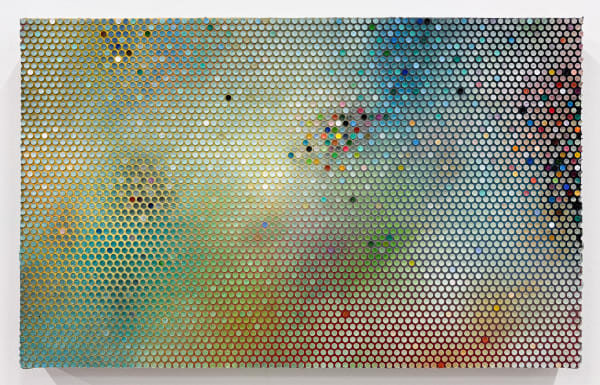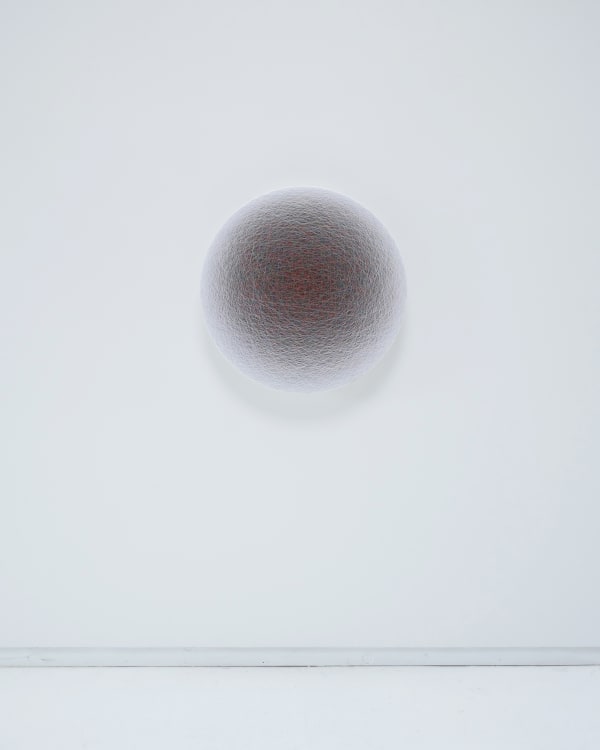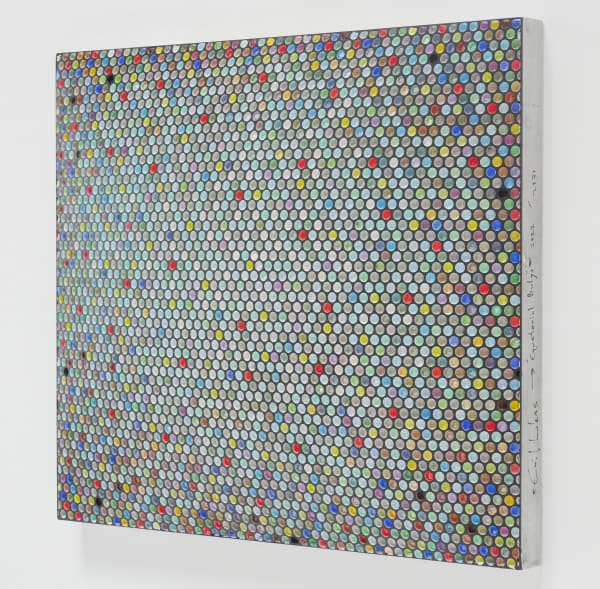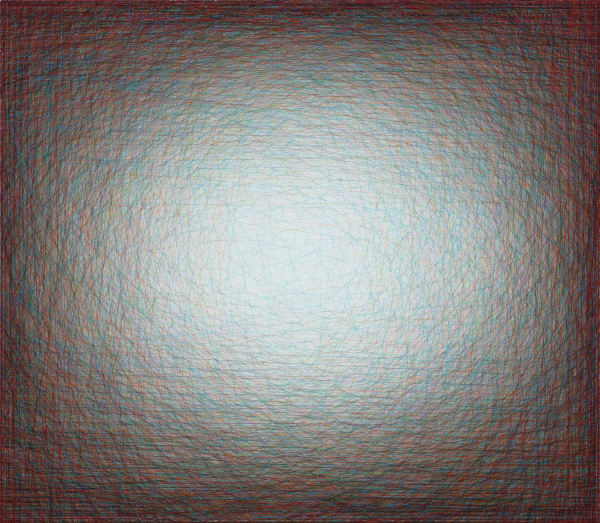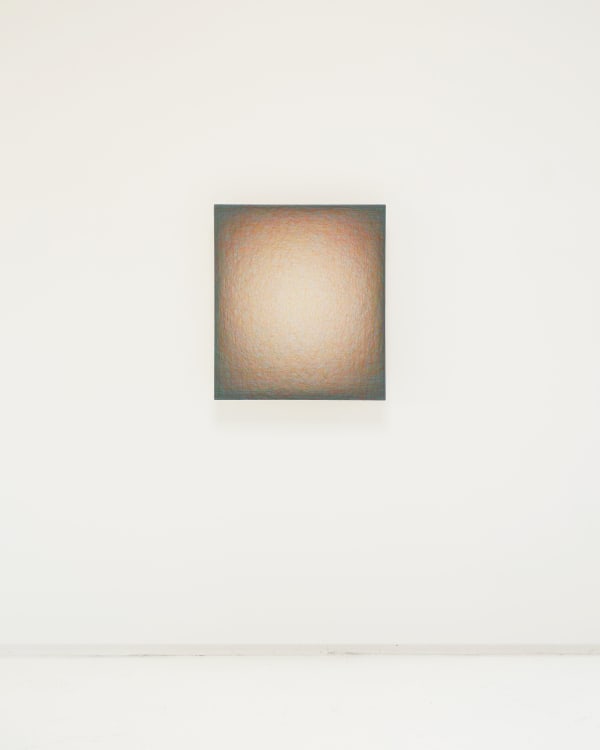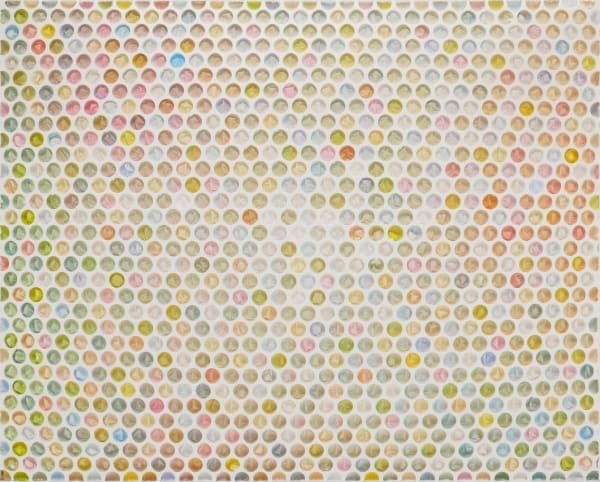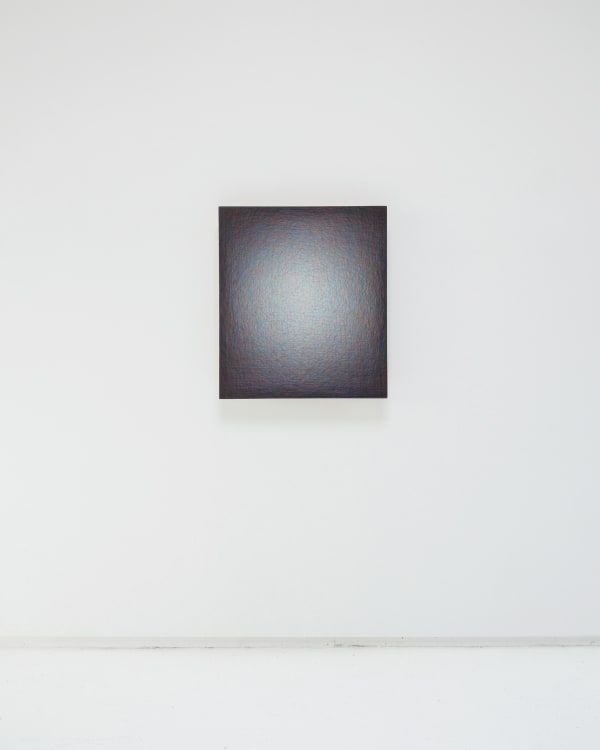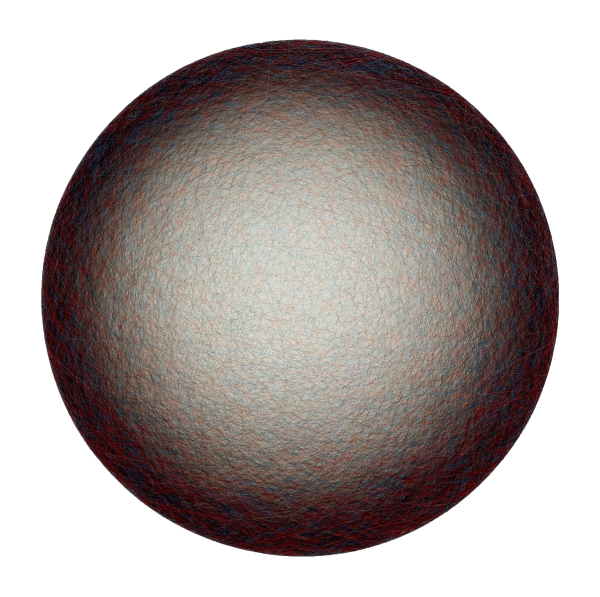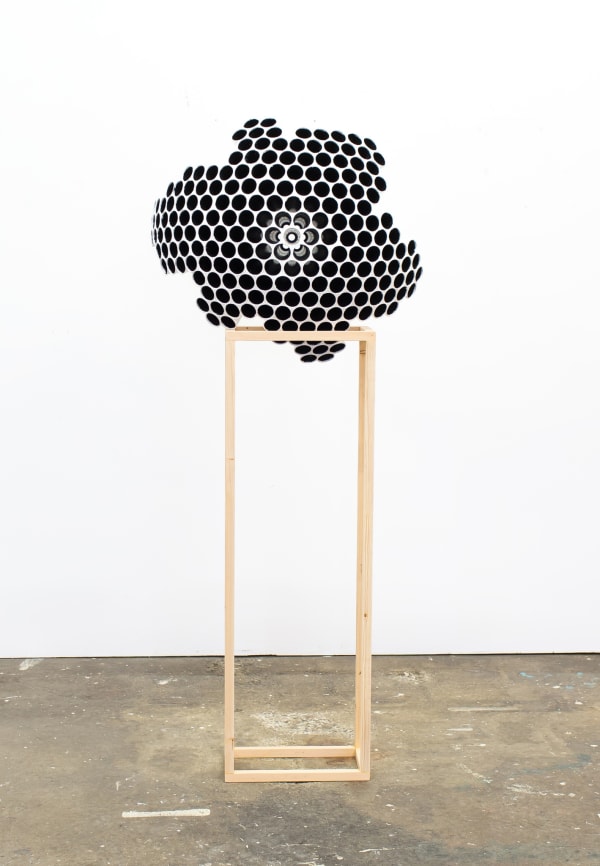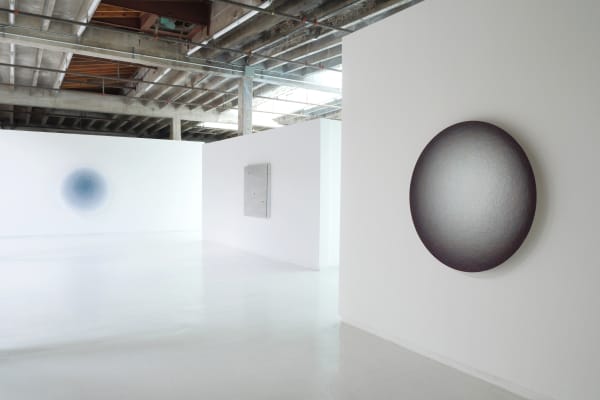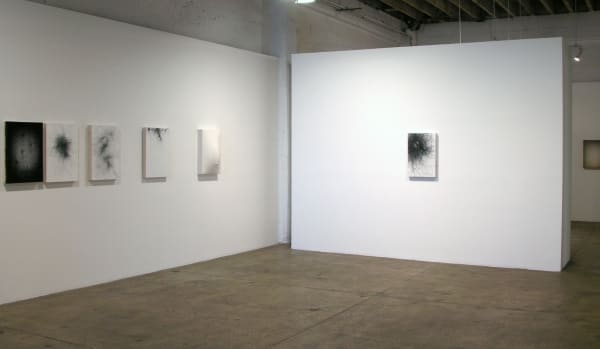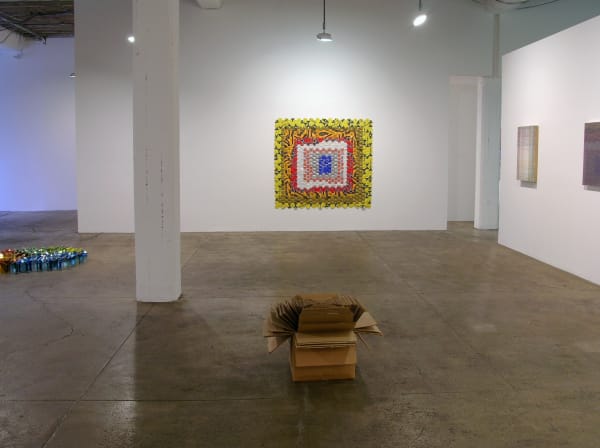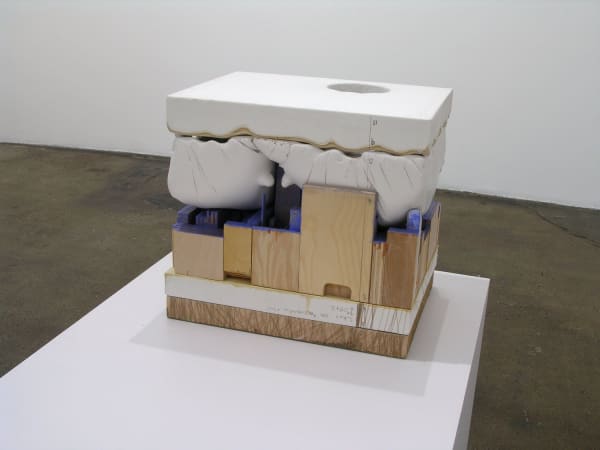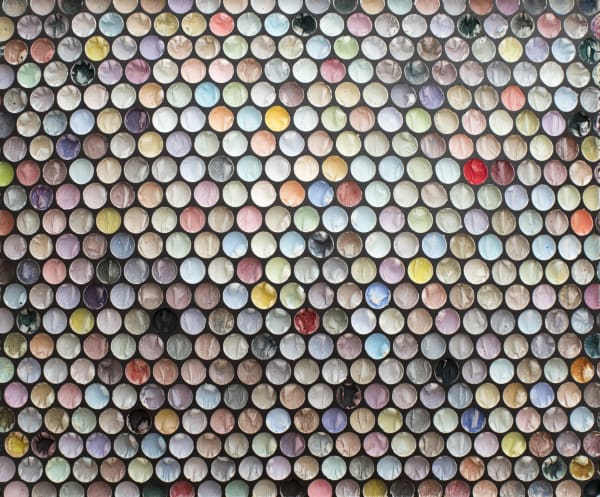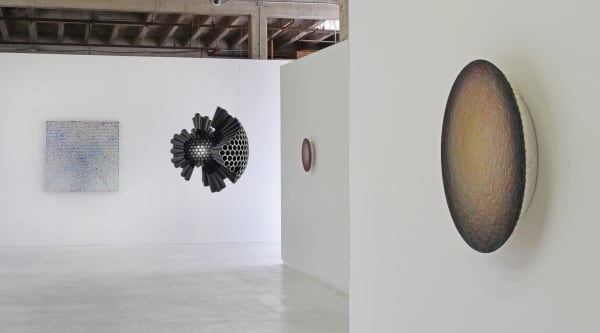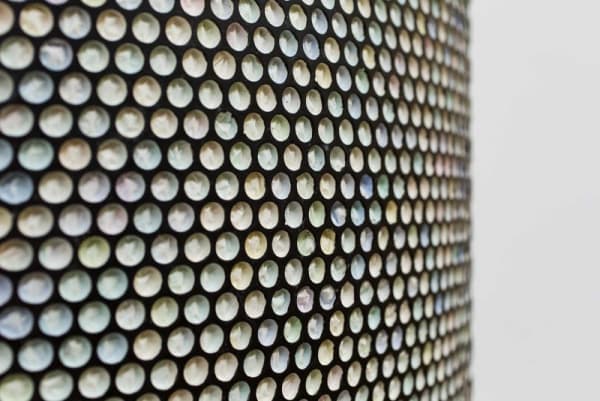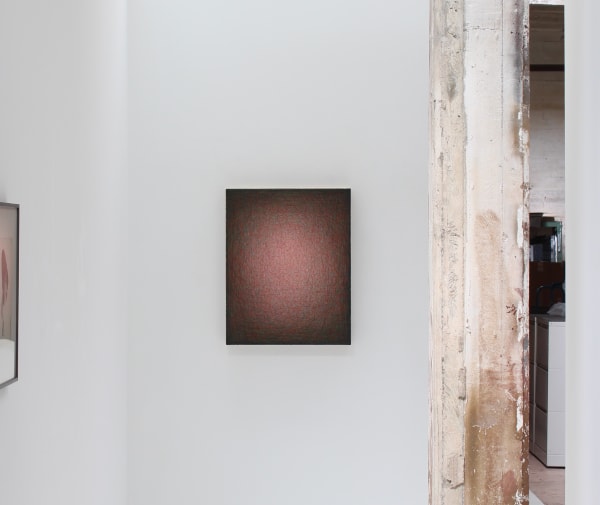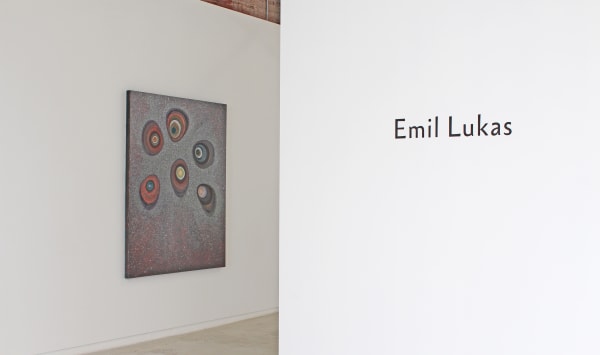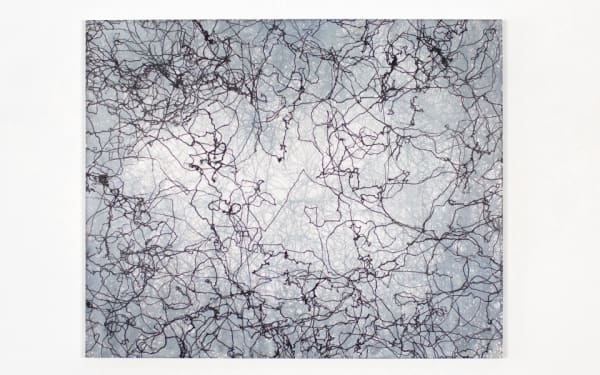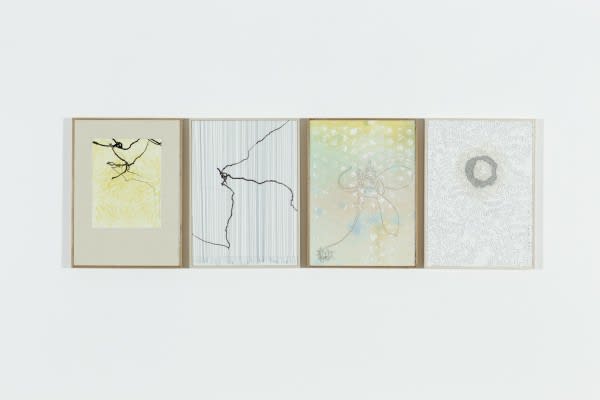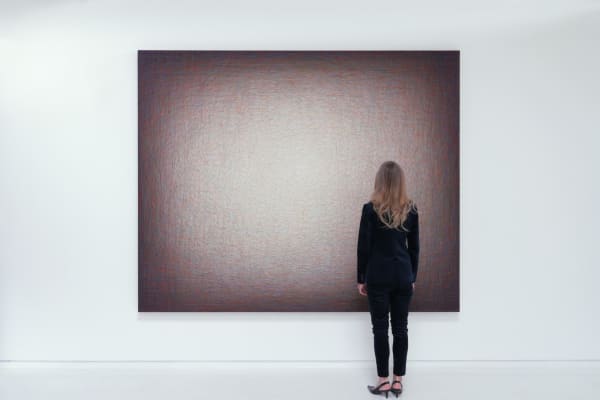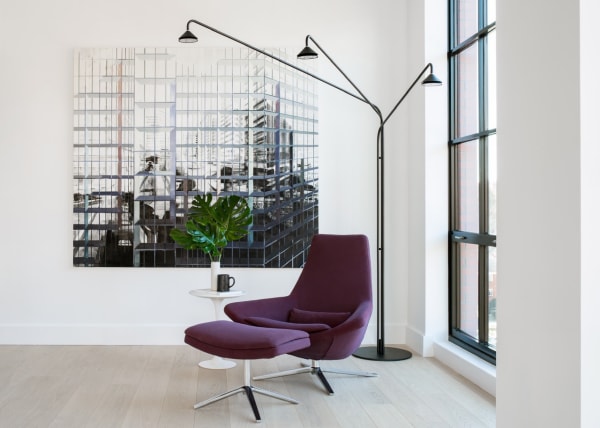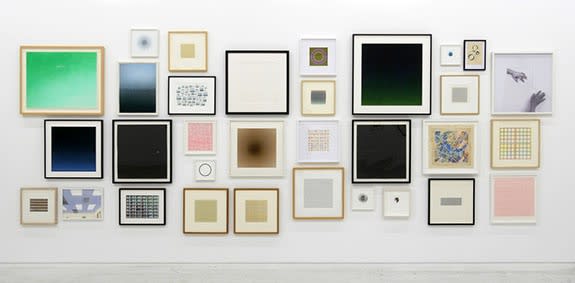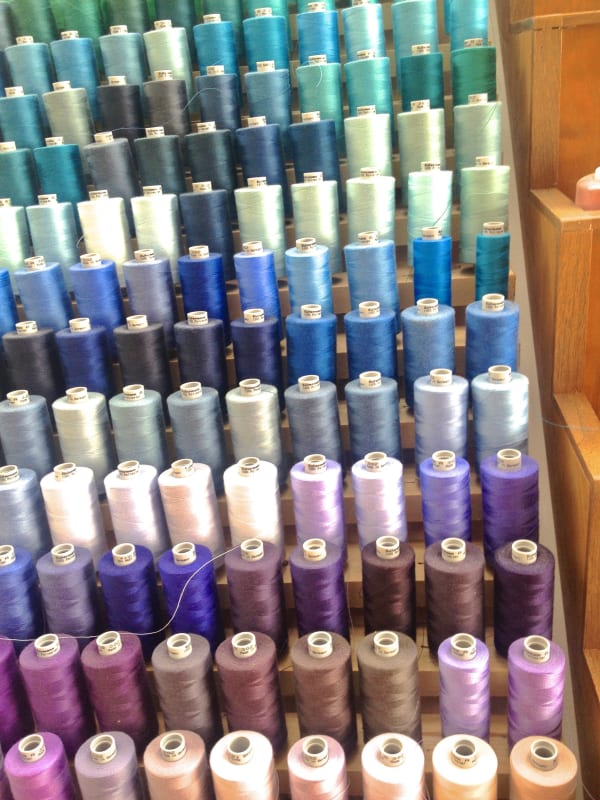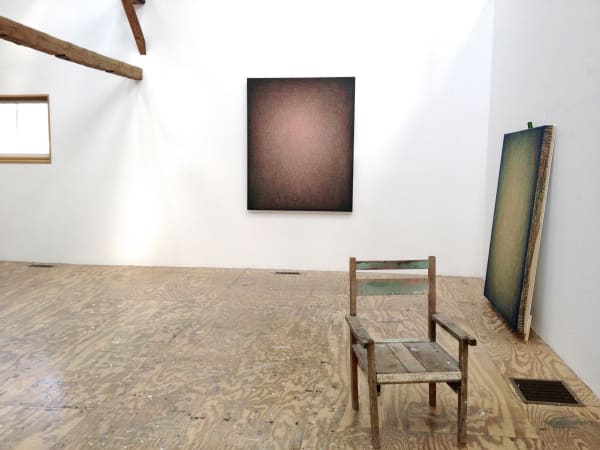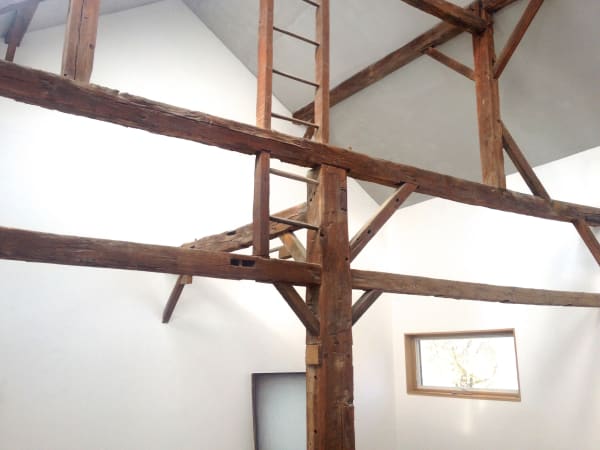Emil Lukas makes evident every process and part that goes into his work. Byproducts of his studio practice and the natural environment become source material for and subjects of works that are both painting and sculpture. The pieces are histories of their own inspiration and construction. Wide-ranging materials, including paper coffee cups used to mix paint, bottle caps, plaster casts of objects and body parts, organic residue, string, and bubble wrap are part of the archeology of each piece and the vocabulary of them all.
One of Lukas' most eccentric processes uses living fly larvae to drag ink across a surface. Small works testify to the power of an individual calligraphic line. Large works made from the paths of tens of thousands evoke vascular systems, clouds of interstellar gasses, or interlaced tree branches as though viewed from below.
Chunky cast-plaster works are composed of a honeycomb of multitudes of cells, individually stained through an accrual of water-soluble pigments that get blotted out, are allowed to soak in, or evaporate to leave their crusty evidence. Seen head-on, the multi-colored pixels create shimmering fields — a kind of nonobjective pointillism. Viewed from the edge, they have the sculptural quality of soft stone, pitted and polished by water.
Lukas may be best known for his "Thread paintings" - shallow wood or metal supports, some with plaster concave backing, over which he criss-crosses thread to create complex, glowing color fields. Each an experiment in color theory, they're optical, phenomenological and astonishing.
Emil Lukas was born in Pittsburgh, PA in 1964 and lives near Stockertown, PA. He has exhibited extensively internationally and has been collected by, among others, the San Francisco Museum of Modern Art, Crystal Bridges Museum of American Art, Denver Art Museum, Museum of Contemporary Art San Diego, and the prestigious Panza di Biumo Collection.
-

Emil Lukas
Detectable with Distance 28 Mar - 9 May 2026Read more -

Drawn to Drawing
12 Jul - 16 Aug 2025Todd Hosfelt combines approximately 200 drawings in an installation designed to reveal thematic and conceptual relationships across time and place. In drawings spanning the globe as well as the 16th...Read more -

Emil Lukas
Fine Line 20 Oct - 22 Nov 2023Emil Lukas' wall-hanging sculptures reimagine painting both materially and structurally. In his Thread Paintings, Lukas constructs shallow wooden trays or parabolic plaster bowls across which he stretches tens of thousands...Read more -

OFF THE GRID: Post-Formal Conceptualism
11 Apr - 20 May 2023This sprawling group exhibition traces the use of the form of the grid in contemporary art, beginning with some of its most illustrious mid-20th century proponents. From there, it examines...Read more -

Where We Are
23 Oct - 24 Nov 2021In a group exhibition marking this moment in history (and celebrating the 25th anniversary of Hosfelt Gallery) the work of 34 artists is employed to reflect on the zeitgeist of...Read more -

Emil Lukas
All Connected, Like It or Not 5 Dec 2020 - 16 Jan 2021Confounding and exquisitely strange, the objects that Emil Lukas develops out of his alchemical studio practice are meditations on the workings of the universe. Lukas interweaves the organic and mineral,...Read more -

BETWEEN THEM
An Installation Composed of Drawings 13 Jul - 17 Aug 2019Todd Hosfelt combines approximately 200 drawings in an installation designed to reveal thematic and conceptual relationships across time and place. In drawings spanning the 16th to 21st centuries, from European...Read more -

Emil Lukas
Twin Orbit 5 May - 16 Jun 2018Emil Lukas’ exquisitely strange and phenomenological objects are meditations on the way we perceive the world. “We’re affected by lots of things that are larger than us — things we...Read more -

20th Anniversary Exhibition
Banerjee, Campbell, Crotty, DeFeo, Hawkinson, Higgins, Kürten, Lukas, Maggi, O'Reilly, Ouadahi, Piccinini, Porter, Pwerle, Rath, Rodriguez, Schoultz, Wiley, Basquiat, Cave, Hansen, Ruscha, Sikander, and Wilke. 9 Sep - 8 Oct 2016Hosfelt Gallery celebrates its 20th anniversary with an exhibition exploring what makes an artwork significant and lasting, and the qualities that distinguish the most innovative artists of our era. This...Read more -

Particle and Wave
Campbell, DeFeo, Hawkinson, Lukas, Maggi, Conner, Derges, Donovan, Ehm, Fuss, Klotz, Marioni, McCaw, Outlaw, Tomasello 6 Feb - 19 Mar 2016“Particle and Wave” is a group exhibition of sculpture, photography and technological media in which artists explore the properties of light. Reflection, refraction and color theory are used as tools...Read more -

Emil Lukas
Ringing of Distant Events 21 Mar - 9 May 2015In Ringing of Distant Events, Emil Lukas presents four disparate types of work whose unconventional media and quirky techniques are completely dissimilar. Yet they are unified by an experimental approach...Read more -

Holding It Together: Collage, Montage, Assemblage
12 Jul - 16 Aug 2014RINA BANERJEE, JAY DEFEO, TIM HAWKINSON, EMIL LUKAS, JOHN O'REILLY, PATRICIA PICCININI, LILIANA PORTER, ALAN RATH, ANDREW SCHOULTZ, WILLIAM T. WILEY, BRUCE CONNER, JEAN CONNER, JOHN ASHBERY, JOE BRAINARD, SARAH...Read more -

Look Both Ways
Banerjee, Campbell, Crotty, Danziger, DeFeo, Faruqee, Phungrasamee Fein, Haeckel, Hawkinson, Lukas, Maggi, O'Reilly, Ouadahi, Porter, Pwerle, Rath 8 Sep - 6 Oct 2012Hosfelt Gallery will inaugurate its new San Francisco venue with the group exhibition, Look Both Ways, opening at 260 Utah Street (at 16th Street) on September 8, 2012. Both a...Read more -

SEMI-PERMEABLE
Julie W. Chang, Jay DeFeo, Jutta Haeckel, Tim Hawkinson, Stefan Kürten, Crystal Liu, Emil Lukas, John O'Reilly, Driss Ouadahi, Janine Antoni, Luka Fineisen, Baseera Khan, Byron Kim, Naomie Kremer, Shahzia Sikander 28 Jun - 17 Aug 2012Hosfelt Gallery, New York Hosfelt Gallery’s summer group exhibition addresses the porous nature of identity and reality. Every living organism is encased by a semi-permeable boundary. This delicate, thin layer...Read more -

Emil Lukas
in, on, un 21 May - 1 Jul 2011Emil Lukas’ fourth solo exhibition with Hosfelt Gallery continues to explore the primacy of process in his practice. Lukas’ work is labor-intensive and experimental. It is playful and poetic. The...Read more -

In Full Color
Campbell, Chang, Faruqee, Haeckel, Liu, Lukas, Ouadahi, Rodriguez, Andrews, Grubin, Houge, Kremer, Mayer, Stenger 9 Jan - 7 Mar 2010New York Gallery John Andrews, Jim Campbell, Julie Chang, Anoka Farquee, Joan Grubin, Jutta Haeckel, Christian Houge, Naomie Kremer, Crystal Liu, Emil Lukas, Gerhard Mayer, Driss Ouadahi, Lordy Rodriguez, Jeremy...Read more -

New Work
Campbell, Faruqee, Lukas, Ouadahi, Porter, Horn, Stenger 1 Jul - 1 Aug 2009New York Gallery NEW WORK: Timothy Horn, Jim Campbell, Liliana Porter, Driss Ouadahi, Anoka Faruqee, Jeremy Stenger, Emil Lukas, and others.Read more -

Emil Lukas
Titration 13 Dec 2008 - 31 Jan 2009Emil Lukas’ work is driven by the visceral energy of studio practice and the vitality of the cluttered working and living environment. His new works explore the concept of “titration,”...Read more -

Outside the Box
Jim Campbell, Emil Lukas, Marco Maggi, Liliana Porter, Alan Rath, Felipe Barbosa, Jonathan Brand, Rebecca Goldfarb, Paul de Guzman, Byron Kim, Gay Outlaw 15 Dec 2007 - 2 Feb 2008So there’s this old visual puzzle of a nine dot grid (3 dots by 3 dots). You’re probably familiar with it. Or, if not, the graphic (complete with its solution)...Read more -

Emil Lukas
One to the Other 13 Sep - 27 Oct 2007New York Gallery Emil Lukas evidences the importance of process in labor-intensive pieces derived from the artist’s experiments in unusual combinations of objects and materials. Byproducts of his studio practice...Read more -

Emil Lukas
Recent Sculptures Related Paintings 2 Dec 2006 - 20 Jan 2007Emil Lukas makes evident every process and part that goes into his work. Byproducts of his studio practice and the natural environment become source material for and subjects of works...Read more
-

The Grid Revisited
David M. Roth, Squarecylinder, May 1, 2023 -

‘I Like Drawings”: A Conversation with Todd Hosfelt
Justin Manley, SquareCylinder, August 5, 2019 -

Emil Lukas: The Art of Bubble Wrap, Thread, and Larvae
David Behringer, Design Milk, February 19, 2019 -

Emil Lukas @ Hosfelt
Jake Weigel, Squarecylinder, May 24, 2018 -

Gallery Chat: Technology Art Champion Todd Hosfelt Opens Innovative Digital Media Conservation Lab
Nicole Casamento, The ADAA, February 17, 2016 -

Emil Lukas at PAFA: Magic made from cardboard, string, and bubble wrap
Michael Lieberman, ArtBlog, January 29, 2016 -

What We Saw at Art Basel Miami Beach, Ranked from Least to Most Ridiculous
Ryan Bort, Newsweek, December 9, 2015 -

Emil Lukas: Ringing of Distant Events
Danica Willard Sachs, Art Practical, May 7, 2015 -

Emil Lukas @ Hosfelt
Julia Couzens, SquareCylinder, May 2, 2015 -

Chance Encounters
Kenneth Baker, 1stDibs Introspective Magazine, April 20, 2015 -

Emil Lukas: Art from maggots, bubble wrap and sewing notions
Kimberly Chun, San Francisco Chronicle, March 18, 2015 -

The Pursuit of Superhuman Randomness: How Emil Lukas Elevates the Everyday to the Otherworldly
Heather Corcoran, Artsy.net, October 29, 2014 -

Abstract Larvae Paintings Are Physical Feats of Creation
Elizabeth Manus, Artnet, July 6, 2014 -

Emil Lukas, Weaving Art with Nature
Blouin Artinfo, January 10, 2014 -

Andrews and Lukas at Hosfelt
Kenneth Baker, San Francisco Chronicle, December 27, 2008
-

Emil Lukas at MACA
"Between two faint lines" January 6, 2023The Pablo Atchugarry Foundation and the Atchugarry Museum of Contemporary Art – MACA present the American artist Emil Lukas for the first time in Uruguay....Read more -

HG Magazine Issue no. 23
Emil Lukas at the gallery & in the studio; plus Suzusan Pop Up Shop, Tim Hawkinson, Crystal Liu, movie recommendation December 2, 2020Emil Lukas: All Connected, Like It or Not opens December 5 Suzusan Pop Up Shop @ Hosfelt Gallery In the Studio: Emil Lukas New to...Read more -

HG Magazine Issue no. 7
Max Gimblett joins gallery; plus Lukas, Fein, Campbell, Hawkinson and Hilma af Klint documentary May 21, 2020Hosfelt Gallery announces representation of Max Gimblett Emil Lukas, Nicole Phungrasamee Fein and Jim Campbell share work from their studio New To Inventory: Tim Hawkinson...Read more -

HG Magazine Issue no. 3
Surabhi Saraf, Andrea Higgins, Rosie Lee Tompkins @ Berkeley Art Museum, soda bread recipe April 23, 2020Surabhi Saraf's mesmerizing video FOLD is featured Andrea Higgins shares a work in progress from her studio New to Inventory: Emil Lukas We recommend Rosie...Read more -

‘I Like Drawings”: A Conversation with Todd Hosfelt
Squarecylinder August 5, 2019Drawing, as Hosfelt has envisioned it, appears to have the structure of a decentralized network, patterned through endlessly overlapping family resemblances without any single center...Read more
-

FOG Design + Art 2026
22 - 25 Jan 2026Artworks by Midcentury masters - Harry Bertoia, Bruce Conner, Jay DeFeo, Jess (Burgess Collins) and Wayne Thiebaud - are juxtaposed with pieces by contemporary international...Read more -

Fog Design + Art 2025
23 - 26 Jan 2025Artwork by San Francisco masters Bruce Conner, Jay DeFeo, Jess (Burgess Collins), and Wayne Thiebaud juxtaposed with works by contemporary artists Mansur Nurullah, Jutta Haeckel,...Read more
-

FOG Design + Art 2026
22 - 25 Jan 2026Artworks by Midcentury masters - Harry Bertoia, Bruce Conner, Jay DeFeo, Jess (Burgess Collins) and Wayne Thiebaud - are juxtaposed with pieces by contemporary international...Read more -

Fog Design + Art 2025
23 - 26 Jan 2025Artwork by San Francisco masters Bruce Conner, Jay DeFeo, Jess (Burgess Collins), and Wayne Thiebaud juxtaposed with works by contemporary artists Mansur Nurullah, Jutta Haeckel,...Read more -
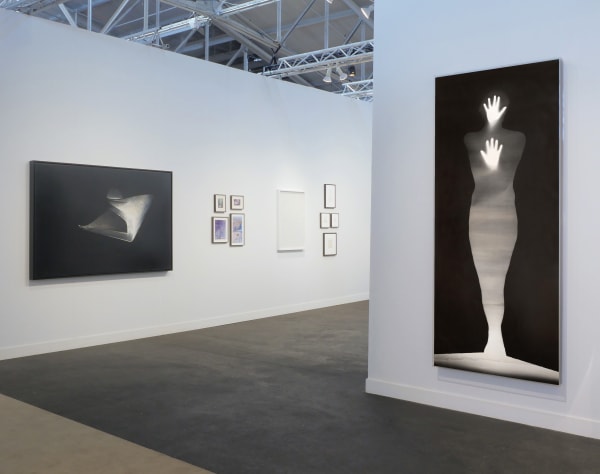
FOG Design + Art 2023
19 - 22 Jan 2023An ethereal installation focusing on relationships between mid-century, Bay Area masters Jay DeFeo, Jess, Bruce Conner and Jean Conner with contemporary international artists including Jutta...Read more -

PULSE Miami Beach
6 - 9 Dec 2018Our PULSE Miami Beach 2018 booth selection highlights the wide range of our international program with artists from Australia, India, Uruguay, Argentina, England, and the...Read more -

Art Toronto
26 - 29 Oct 2018Hosfelt Gallery will present a curated booth of five artists – one from Australia, two from the U.S., one from Germany and one from Canada...Read more -

Dallas Art Fair
13 - 15 Apr 2018Hosfelt Gallery presents artworks by Jim Campbell, Jutta Haeckel, Stefan Kürten, Emil Lukas, Marco Maggi and Cornelius Völker at The Dallas Art Fair 2018.Read more -
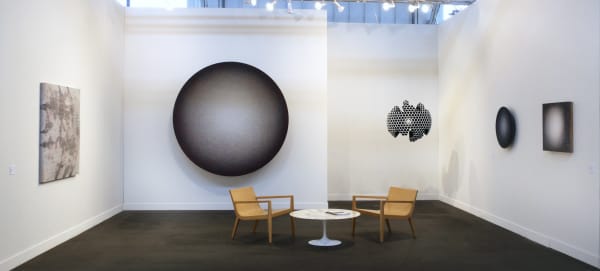
FOG Design+Art: Emil Lukas
11 - 14 Jan 2018For those who’ve watched Emil Lukas’ development in the nearly 30 years that he’s been exhibiting in the Bay Area, the roots of these new...Read more -
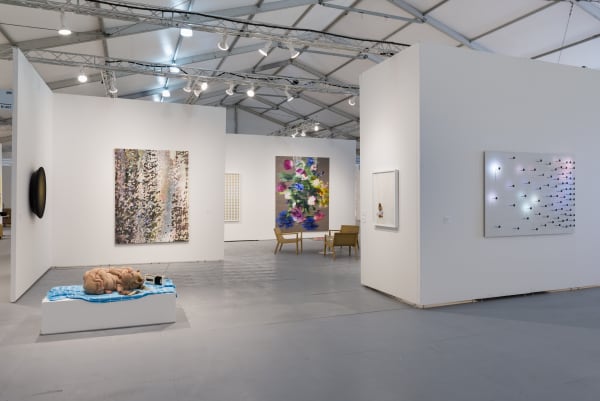
PULSE Miami Beach
7 - 10 Dec 2017Hosfelt Gallery will feature Jim Campbell, Jutta Haeckel, Stefan Kürten, Emil Lukas, Marco Maggi, Ben McLaughlin, Patricia Piccinini, Liliana Porter, Alan Rath, Andrew Schoultz, and...Read more -
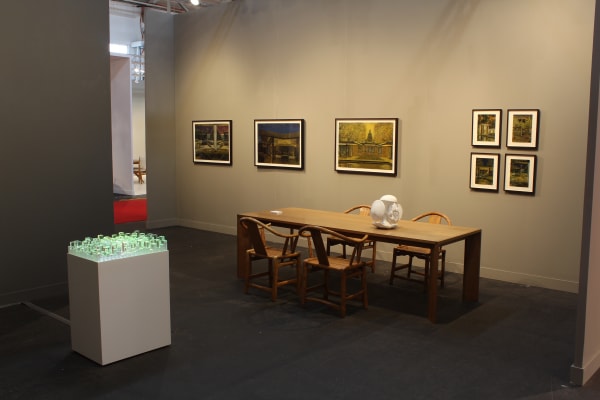
FOG Design+Art
11 - 15 Jan 2017Presenting a curated selection of paintings, works on paper, photographs, electronic sculpture, and unique furniture by both local and international artists and designers. The presentation...Read more -
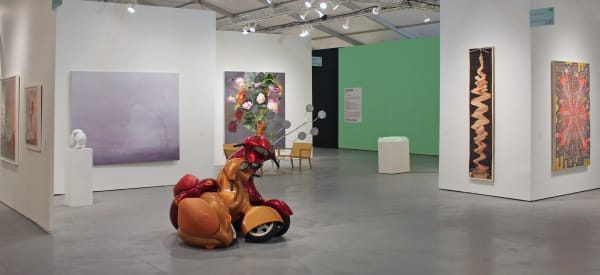
PULSE Miami Beach
1 - 4 Dec 2016Hosfelt Gallery will present artworks by Jim Campbell, Tim Hawkinson, Crystal Liu, Emil Lukas, Driss Ouadahi, Patricia Piccinini, Andrew Schoultz, and Cornelius Völker at PULSE...Read more -
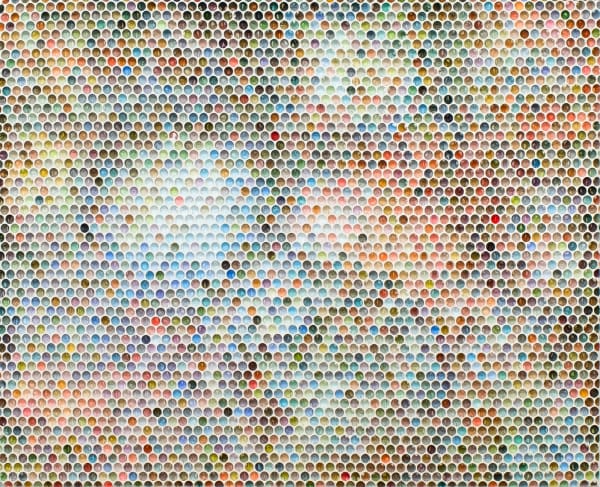
Dallas Art Fair: Emil Lukas
14 - 17 Apr 2016Hosfelt Gallery presents a solo booth of artworks by Emil Lukas for The Dallas Art Fair 2016.Read more








